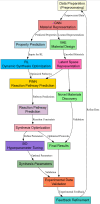An integrated AI-driven framework for maximizing the efficiency of heterostructured nanomaterials in photocatalytic hydrogen production
- PMID: 40640304
- PMCID: PMC12246241
- DOI: 10.1038/s41598-025-10785-6
An integrated AI-driven framework for maximizing the efficiency of heterostructured nanomaterials in photocatalytic hydrogen production
Abstract
The urgency for sustainable and efficient hydrogen production has increased interest in heterostructured nanomaterials, known for their excellent photocatalytic properties. Traditional synthesis methods often rely on trial-and-error, resulting in inefficiencies in material discovery and optimization. This work presents a new AI-driven framework that overcomes these challenges by integrating advanced machine-learning techniques specific to heterostructured nanomaterials. Graph Neural Networks (GNNs) enable accurate representations of atomic structures, predicting material properties like bandgap energy and photocatalytic efficiency within ± 0.05 eV. Reinforcement Learning optimises synthesis parameters, reducing experimental iterations by 40% and boosting hydrogen yield by 15-20%. Physics-Informed Neural Networks (PINNs) successfully predict reaction pathways and intermediate states, minimizing synthesis errors by 25%. Variational Autoencoders (VAEs) generate novel material configurations, improving photocatalytic efficiency by up to 15%. Additionally, Bayesian Optimisation enhances predictive accuracy by 30% through efficient hyperparameter tuning. This holistic framework integrates material design, synthesis optimization, and experimental validation, fostering a synergistic data flow. Ultimately, it accelerates the discovery of novel heterostructured nanomaterials, enhancing efficiency, scalability, and yield, thus moving closer to sustainable hydrogen production with improvements in photolytic efficiency, setting a benchmark for AI-assisted research.
Keywords: Graph neural networks; Heterostructured nanomaterials; Hydrogen production; Physics-Informed neural networks; Reinforcement learning.
© 2025. The Author(s).
Conflict of interest statement
Declarations. Competing interests: The authors declare no competing interests.
Figures








Similar articles
-
Numerical modeling and neural network optimization for advanced solar panel efficiency.Sci Rep. 2025 Jul 2;15(1):23492. doi: 10.1038/s41598-025-06830-z. Sci Rep. 2025. PMID: 40604001 Free PMC article.
-
Stabilizing machine learning for reproducible and explainable results: A novel validation approach to subject-specific insights.Comput Methods Programs Biomed. 2025 Sep;269:108899. doi: 10.1016/j.cmpb.2025.108899. Epub 2025 Jun 21. Comput Methods Programs Biomed. 2025. PMID: 40570739
-
Short-Term Memory Impairment.2024 Jun 8. In: StatPearls [Internet]. Treasure Island (FL): StatPearls Publishing; 2025 Jan–. 2024 Jun 8. In: StatPearls [Internet]. Treasure Island (FL): StatPearls Publishing; 2025 Jan–. PMID: 31424720 Free Books & Documents.
-
Health professionals' experience of teamwork education in acute hospital settings: a systematic review of qualitative literature.JBI Database System Rev Implement Rep. 2016 Apr;14(4):96-137. doi: 10.11124/JBISRIR-2016-1843. JBI Database System Rev Implement Rep. 2016. PMID: 27532314
-
How lived experiences of illness trajectories, burdens of treatment, and social inequalities shape service user and caregiver participation in health and social care: a theory-informed qualitative evidence synthesis.Health Soc Care Deliv Res. 2025 Jun;13(24):1-120. doi: 10.3310/HGTQ8159. Health Soc Care Deliv Res. 2025. PMID: 40548558
References
-
- Younas, M., Shafique, S., Hafeez, A., Javed, F. & Rehman, F. An overview of hydrogen production: current status, potential, and challenges. Fuel316, 123317 (2022).
-
- Marghade, D. et al. Innovations in metal-organic frameworks (MOFs): pioneering adsorption approaches for persistent organic pollutant (POP) removal. Environ. Res.258, 119404 (2024). - PubMed
-
- Antil, B. & Deka, S. Porous graphitic carbon nitride nanostructures and their application in photocatalytic hydrogen evolution reaction. Heterogen. Nanocatalysis Energy Environ. Sustain., 133–163. 10.1002/9781119772057.ch5 (2022).
-
- Cheng, C. et al. Amorphous versus crystalline CoSx anchored on CNTs as heterostructured electrocatalysts toward hydrogen evolution reaction. Sci. China Mater.66, 1383–1388 (2023).
LinkOut - more resources
Full Text Sources

